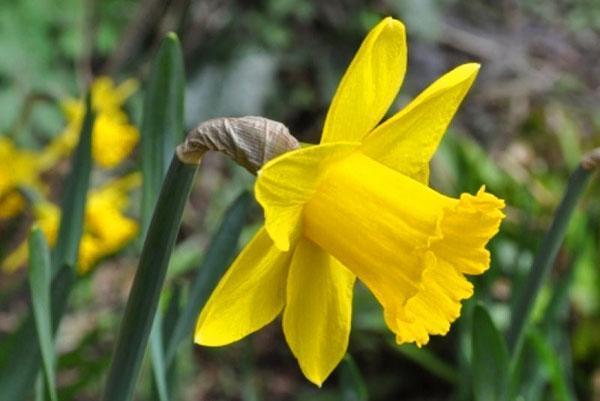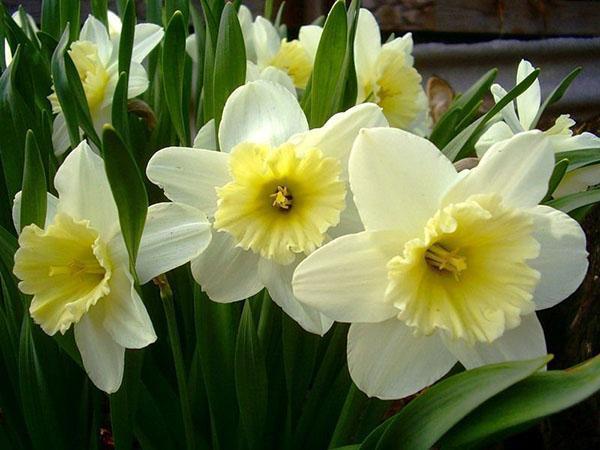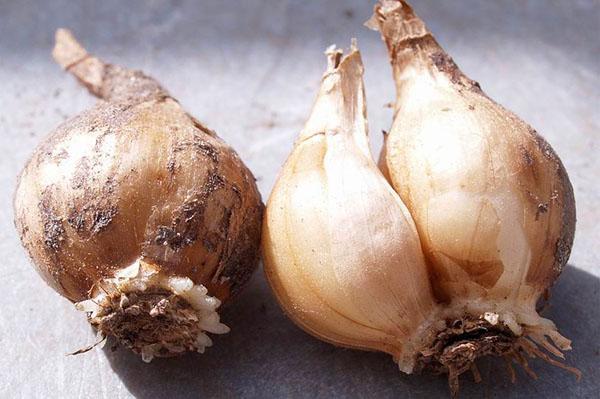Outdoor planting of solar daffodils
 In the world of gardeners, spring and tender daffodils are incredibly popular, and planting and caring for them in the open field is quite simple. It is interesting that the unpretentious flower is suitable both for growing in flower beds and plots, and for decorating apartment windowsills. Of course, daffodils have some peculiarities of planting and subsequent care.
In the world of gardeners, spring and tender daffodils are incredibly popular, and planting and caring for them in the open field is quite simple. It is interesting that the unpretentious flower is suitable both for growing in flower beds and plots, and for decorating apartment windowsills. Of course, daffodils have some peculiarities of planting and subsequent care.
Description of spring flowers

Narcissus is distinguished by flowering in early spring and a scent reminiscent of honey. The buds most often have a white or yellow tint. The length of the peduncles ranges from 25 to 40 cm. The leaves are narrow, erect and elongated.
There are many types and varieties of narcissus. Moreover, these differ not only in appearance, but also in the flowering period. Therefore, when choosing a culture, you should carefully study the packaging. On average, a daffodil blooms for 10-14 days. If you correctly approach planting a plant and decorating a flower bed, you can observe the flowering of different varieties from the last days of March until the end of spring.
Preparing for landing

At the initial stage, planting and caring for daffodils outdoors begins with preparation, which includes the following steps:
- Choosing a place. Daffodils are distinguished by their ability to adapt to any conditions, so they can be planted both in the shade and in an open sunny area. However, it is worth clarifying that under direct rays the plant produces more buds and, in general, feels much better. It is also worth taking care of protection from drafts. In one place, a plant can live up to 5 years.
- Priming. The soil for daffodils should have excellent air permeability, excellent moisture permeability. The plant does not like stagnant water. The best option would be loamy soil with neutral acidity. Approximately 3 months before planting, you will need to dig up to a depth of 35 cm and cultivate the site. Add 3-4 kg of compost, peat... For sandy soil, clay with humus can be used, and heavy soil can be diluted with coarse sand, 20 kg per 1 sq. m.
Daffodils do not tolerate manure, therefore, its use as fertilizer is unacceptable. The only option may be to apply it at least a year before planting in the selected area.
Additionally, experts recommend how to feed the daffodils in the spring. Mineral compositions are suitable in proportions:
- potash fertilizers - 1 tbsp. l. for 1 sq. m;
- Agricola for flowering plants - 1 tbsp. l. for 1 sq. m;
- superphosphate - 2 tbsp. l. for 1 sq. m.
Fertilizers can be applied in the fall, the main thing is that at least 30 days have passed before planting.
Landing
 Before planting, you need to decide when to plant daffodils best. The first weeks of September, the end of summer, are considered optimal. But in addition, you should focus on the climate of the growing region.
Before planting, you need to decide when to plant daffodils best. The first weeks of September, the end of summer, are considered optimal. But in addition, you should focus on the climate of the growing region.
The general condition that needs to be fulfilled is the temperature indicator of the soil within + 8 ° + 10 ° C, which does not move from these marks for at least 2 weeks. Before the soil freezes, the bulbs should have time to take root, but not grow.
As for the moment whether it is possible to plant daffodils in the spring, opinions differ here. In general, planting is acceptable, but there is a high risk that the plant will be weak. When grown this way, the bulb will mature later and flowering is likely to be delayed. In this case, the optimal period for planting bulbs is April. In this case, planting in the ground in the spring should be carried out only after the snow melts and the air warms up to + 7 ° C.
Next, you need to purchase quality material. The bulbs can be bought at the store, while paying attention to the integrity and the absence of rotten parts. It is also necessary that the bulb is large enough, at least 5 cm in diameter, otherwise it will have to be grown and it will not germinate soon. It is also worth remembering that growing daffodils outdoors requires the bulbs to be firm to the touch.
Before planting, you can treat the material with a fungicidal agent or 0.1% potassium permanganate solution. Further, in the prepared area, holes are formed, the depth of which is calculated by multiplying the diameter of the bulb by 3. The distance between the holes is 10-12 cm.
In order for the buds to appear as early as possible, and the bulb has overgrown with the largest number of children, it is worth deepening it a little shallower than necessary. To achieve the opposite result, the bulb is planted deeper.
Inside, the hole is sprinkled with a layer of river sand. At the time of planting, the onions are placed upside down and pressed. Above the flower bed is mulched with a layer of peat 3-4 cm. At the first frost, the area is covered with fallen leaves. In the spring, after the snow melts, the soil is loosened.
 As for how to plant daffodils in spring, there is nothing difficult here either. You will need to purchase material and place it in a refrigerator or cellar for the winter, only in this case the plant will bloom. Further stages, including processing of the material, burying the bulbs, are similar to those for autumn planting. In conclusion, the soil is tamped and watered.
As for how to plant daffodils in spring, there is nothing difficult here either. You will need to purchase material and place it in a refrigerator or cellar for the winter, only in this case the plant will bloom. Further stages, including processing of the material, burying the bulbs, are similar to those for autumn planting. In conclusion, the soil is tamped and watered.
Daffodil care
 So, how to care for daffodils outdoors. A number of key points can be highlighted here:
So, how to care for daffodils outdoors. A number of key points can be highlighted here:
- Watering. It is necessary to irrigate the soil as it dries, but the formation of a hard crust should not be allowed. Watering should be continued until the point of wilting.
- Weeding, loosening. Weeds should be removed periodically and the soil should be loosened. This will improve breathability and slow down the evaporation of moisture.
In addition, tender daffodils, when planting and caring in the open field, need additional feeding. It is optimal to apply fertilizers 2 times:
- Top dressing in the phase of inflorescence formation. Ingredients: 1 tsp. superphosphate, urea, potassium sulfate are dissolved in 10 liters of water. Consumption is 5 liters per 1 sq. m.
- Top dressing at the beginning of flowering. Ingredients: 1 tsp. Dissolve nitrophosphate, Agricola-7 and Effekton fertilizers in 10 liters of water.
In a rainy summer, it is recommended to replace liquid top dressing with dry formulations. To do this, in early spring, you need to scatter 1 tsp. superphosphate, "Agricola-7", potassium sulfate, wood ash, urea per 1 sq. m of soil.
Leaving after the end of flowering
 Good post-flowering daffodil care involves pruning and harvesting the bulbs. It is important not to rush to remove drying twigs and leaves. It is necessary to wait until the parts of the plant are completely dry, but dry buds can be harvested immediately.
Good post-flowering daffodil care involves pruning and harvesting the bulbs. It is important not to rush to remove drying twigs and leaves. It is necessary to wait until the parts of the plant are completely dry, but dry buds can be harvested immediately.
The bulbs should be removed before starting new rooting, after the foliage turns yellow.
At the end, the planting material is cleared of soil and plant parts. They are dried at a temperature of at least + 20 ° C. Then the children are separated and treated with an antiseptic. Then they are thoroughly dried again.
Store the material at + 25 ° C for 7 days. Then transferred to a cool and dark place and left until planting.
Planting and caring for fragrant daffodils is so easy that any gardener can handle it. In addition, the bright and sunny flowering of buds can decorate both a summer cottage and designs and flower beds created by masters.The main thing is not to be lazy and follow the existing rules for planting a plant.